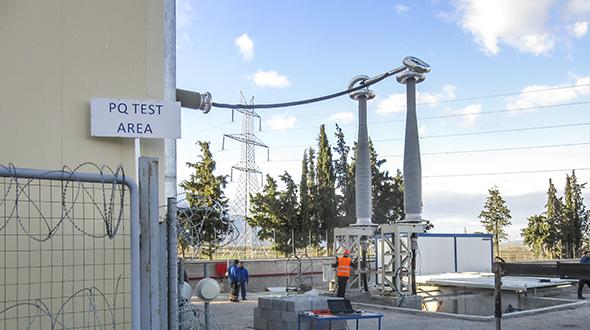For the enamelled conductor cables that were used in the qualification testing, PFISTERER developed the new efficient Frontcon connector.
With the official qualification, in which all tests required under IEC 62067 were successfully passed, PFISTERER has further expanded its high-voltage range. Ixosil outdoor terminations and slip-on joints, CONNEX separable cable connectors and sockets, and the gas-insulated CONNEX joint for the voltage level up to 420 kV – like all of the independent accessory manufacturer’s products – are universally deployable and compatible with all XLPE cables by all suppliers. They therefore form the basis for efficient partnerships.
Fast installation of enamelled conductor cables with Frontcon
The first cable-specific system test for 420 kV was carried out in partnership with Hellenic Cables Group. “In this project, the challenge was not only the voltage level, which was new for us, but also the conductors with enamelled strands. With these cables, which are designed specifically for the transmission of high currents, the so-called skin effect is reduced. However, installing them used to be extremely time-consuming, because each individual strand had to be stripped. This is no longer necessary with our newly developed connection technology. The front-face connector Frontcon is quick and easy to install, and functions very reliably,” reports Michael Christen, laboratory project manager business unit PTS Cable at PFISTERER.
Tested under tougher conditions
For the qualification, the CONNEX and Ixosil fittings were extensively tested and inspected. For the system test and subsequent pre-qualification (PQ), not only the requirements of Greek grid operator PPC but also those of several European transmission system operators were taken into account. These specific needs made the test even more challenging than it already was under IEC 62067. For the type test, which was performed in the high-voltage lab at the University of Duisburg-Essen, the standard for the cable’s phase-to-earth voltage is usually 220 kV. But because the Greek grid operator requires 230 kV, the level for all tests was set correspondingly higher. Among these was the lightning impulse test, which was initially carried out for 420 kV at 1,425 kV, followed by a further test at 1,550 kV which belongs to the 550 kV voltage level.
Realistic service life simulation
Following the type test, the one-year pre-qualification (PQ) simulated the fittings’ service life of approx. 20 years under realistic conditions, such as burying a joint in the ground. To carry out the extensive procedure, Hellenic Cables Group set up her own open-air PQ test field. “An important point for cable manufacturers is our support with regard to the tests. We possess the know-how plus a great deal of experience, as we have been carrying out these qualification tests internally and externally for decades, and we go through several such tests in parallel every year. Our service in principle covers the project from start to finish: we demonstrate feasibility, supply the fittings, and install them on-site,” says Valentino Magnano, project manager business unit PTS Cable at PFISTERER.
